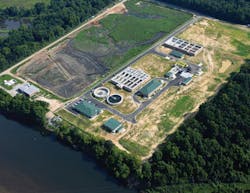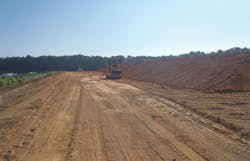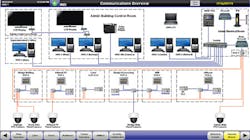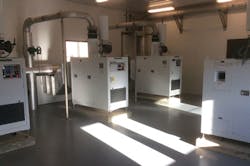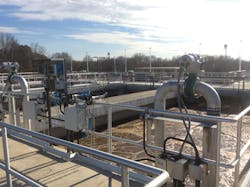New Wastewater Treatment Facility Replaces Aging Lagoon Plant
By Keith B. Cannon, Jr.
A new wastewater treatment plant (WWTP) in Camden, S.C., has replaced an aging lagoon plant that had been in operation for more than 30 years. The old plant was no longer able to adequately treat the city’s wastewater to the effluent limits required by its National Pollutant Discharge Elimination System (NPDES) permit. The new facility has a design capacity of 4 million gallons per day (MGD), an increase from the 3 MGD lagoon plant. Further, several of the unit processes were designed for future expansion to 8 MGD, including the headworks, effluent facility, and solids processing building.
The WWTP includes a headworks facility for influent flow monitoring, coarse and fine screening, grit removal and influent pumping; a multi-stage biological nutrient removal aeration system with anaerobic, anoxic and aerobic treatment zones; secondary clarifiers and scum pumps; an effluent facility for ultraviolet (UV) disinfection, post-aeration and effluent flow monitoring; an effluent diffuser in the Wateree River; and a liquid lime facility for pH control.
Solids treatment includes a solids-processing building that houses the return activated sludge and waste activated sludge pumps, rotary drum thickeners, thickened sludge transfer pumps and aeration system blowers; an aerobic digester and sludge holding tanks; and a sludge transfer pump station that houses the sludge system blowers and digested sludge transfer pumps. Sludge from the plant is ultimately disposed of by land application. The WWTP also has an administration building with a laboratory, maintenance shop, offices, break room and control room, a maintenance storage facility, and a septage receiving station.
Selection of Site
Several possible sites for the WWTP were studied during the preliminary planning stage of the project. The choice was to construct the plant on the site of the existing facility within the footprint of the abandoned lagoon adjacent to the active lagoon to reduce the cost of land acquisition and additional infrastructure. Since the bottom of the existing lagoon was about 12 feet below the top of the surrounding dikes and the final grades needed to be raised another two feet above the dikes due to the flood plain elevation, approximately 350,000 cubic yards of fill material was brought in to infill the lagoon to form the subgrade for the plant.
After performing soil borings within the lagoon footprint, it was determined that the existing subgrade soils had a high potential for differential settlement. In order to circumvent that possibility, the fill material was initially installed in 20-foot-high piles in areas of the planned basins to induce the predicted settlement prior to constructing the facility. That process is known as pre-loading.
The pre-loading phase of the project was completed nine months before the start of construction, allowing the settlement to take place while design and bidding were being completed so that it did not affect the completion schedule. Pre-loading the site allowed for more standard foundation design of the structures in lieu of complex and costly designs such as piles, which ultimately allowed the city to utilize the available project funds more effectively. Constructing the plant on the same site as the existing plant made for an easy, economical transition of influent flow to the new plant. The city also was able to drain the lagoon into the new plant and save funds on dewatering costs.
Innovative Application of Techniques
The plant uses several new technologies in the treatment process. The aeration and sludge holding systems are equipped with high-speed turbo blowers to deliver the required air flow for each system. They are the most energy efficient blowers available and incorporate variable speed drives and programmable logic controllers to allow them to vary the air flow based on the requirements of the system.
The aeration basin is equipped with dissolved oxygen (DO) and oxidation reduction potential sensors in each of its three zones to measure the oxygen demand of the system and transmit it to the blowers via the supervisory control and data acquisition (SCADA) system. The sensors, blowers, and electrically actuated valves on the air lines in the basin provide maximum operational flexibility for the operators and ensure highly efficient treatment of the system.
The UV disinfection system is equipped with a new low-pressure, high-intensity lamp system that is the first global installation of its kind. The UV system uses a ballast technology requiring fewer lamps, which decreases the system’s footprint, and intelligent dose control to minimize the system’s energy consumption. The system includes a compact automatic lifting mechanism to remove the lamp modules from the channels without the need for a crane. This results in easier installation and maintenance of the equipment. The system also includes a chemical-free wiper system to clean the lamps without removing them from the channels.
The post-aeration system consists of a low profile cascade aerator. The system uses air infusion plates and leaping weir assemblies that utilize gravitational forces to achieve the desired DO concentration in the plant effluent for the full range of daily flow while consuming no power and requiring less than three feet of head loss. Influent flow control gates provide optimal performance at low or peak flow rates.
A plant-wide SCADA system was installed to provide local and remote monitoring and control of the entire facility. The system is made up of programmable logic controllers in the control panels for each unit process which transmit all of the signal information through a fiber optic network. Computer work stations are located in the control room and select offices in the administration building. The system also includes security cameras to monitor activities throughout the plant site.
Removal of Contaminants
The new WWTP utilizes a biological nutrient removal design for the biological treatment process. Each of the three zones in the aeration basin is further subdivided into three cells that normally operate in series for maximum efficiency. The anaerobic zone is used to biologically remove phosphorus. A coagulant, aluminum sulfate, is also available to chemically precipitate phosphorus if needed. The anoxic zone is used to remove nitrogen (denitrification). Mixed liquor recycle pumps are used to return aerated mixed liquor from the aerobic zones to the anoxic zones to increase denitrification and recover alkalinity. The aerobic zone removes biochemical oxygen demand and converts ammonia nitrogen to nitrate nitrogen. Air is delivered to the aerobic zones through fine bubble membrane diffusers.
Each cell can be isolated for operational flexibility and ease of maintenance. The combination of the multi-cellular design with the automatic air delivery system provides the most efficient and operational friendly design using proven treatment techniques and technological advances in equipment.
Sustainable Design Considerations
A Cormix model was developed during design to determine effects of the plant’s increased effluent flow on the Wateree River. An effluent diffuser was installed in the river to eliminate any deleterious effects to aquatic life. The diffuser also was designed for future plant expansion to 8 MGD.
In addition, the use of variable frequency drives to operate the various pumps allows the plant to operate at reduced loads during non-peak production times, reducing electrical consumption and the facility’s carbon footprint. The administration building uses low-use plumbing fixtures to reduce water use and occupancy sensors for the light fixtures to reduce electrical costs.
The lagoon was drained and decommissioned. Future plans entail converting the lagoon basin into constructed wetlands as part of a knowledge center. The source water for the wetlands could potentially be the effluent from the WWTP, which would provide for further tertiary treatment prior to discharge to the river.
AECOM and the staff of the City of Camden collaborated on the project from its inception. Completed in just over two years, the project met or exceeded all of the city’s needs, increasing the capacity of the plant while providing for future expansion as well as replacing failing infrastructure and outdated treatment technology with a state-of-the-art facility, improving reliability and functionality to meet permit limits.
About the Author: Keith B. Cannon, Jr., PE, is project manager/senior project engineer for AECOM in Columbia, S.C.

